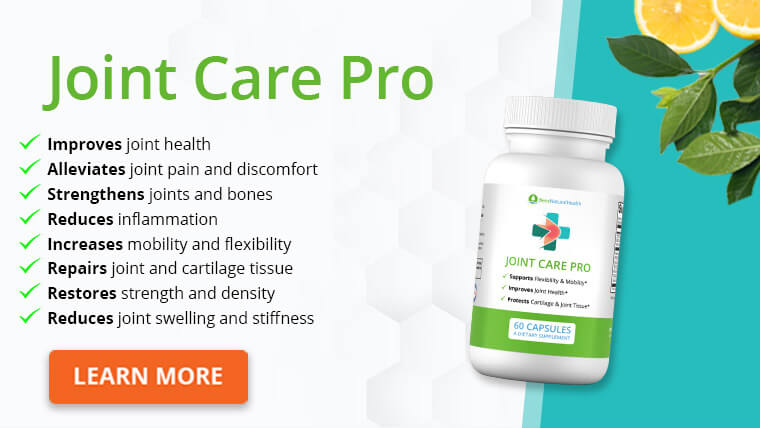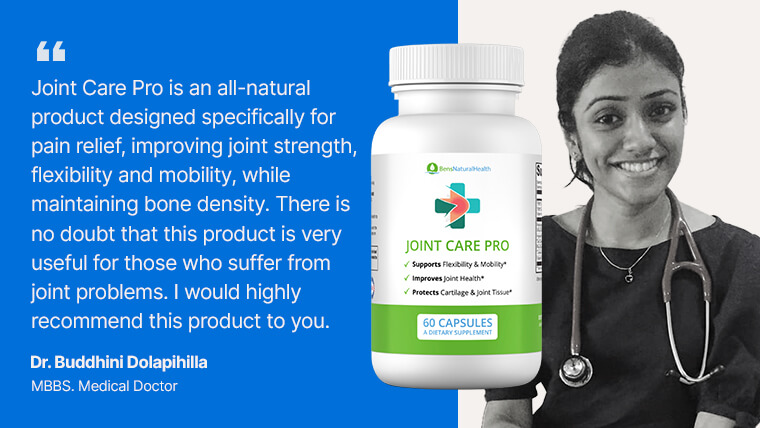- What is Colchicine?
- How does Colchicine work?
- Foods to avoid when taking Colchicine
- Foods to eat while taking Colchicine
- Other things to avoid while taking Colchicine
- Should Colchicine be taken with food?
- What is the best time to take Colchicine?
- How to reduce the side effects of Colchicine
- Any other safety concerns?
- Ben’s Joint Care Pro
- Conclusion
- Source
Gout is estimated to impact at least 9 million people in the United States alone each year.
Your risk for gout increases as you get older, which might lead your healthcare provider to recommend a medication for gout.
Colchicine is one of several medications approved to treat and prevent gout.
If you’ve been prescribed colchicine, you might be wondering if there are foods you should eat and avoid while taking it.
In this article, we’ll go into more detail about what gout is, how it’s treated, and how to prevent it, including foods to eat and avoid if you’re prescribed colchicine for your gout.
What is Colchicine?
Colchicine is a medication used to prevent gout flare-ups. Some brand names for colchicine include Colcrys, Gloperba, and Mitigare, while colchicine is the generic option (which tends to be cheaper).
Gout, or gouty arthritis, is an inflammatory condition that causes painful joint swelling.
Gout is a specific type of arthritis that usually affects one joint at a time.
Most often, the big toe joint is affected, but other joints like your knee and ankle can be impacted by gout.
Gout is caused by a buildup of uric acid in your bloodstream. If your body can’t filter out the excess uric acid, it causes tiny crystal-like substances to form in and around your joint, which is the part that causes the painful inflammation.
Besides treating gout, colchicine is also approved to treat familial Mediterranean fever, a genetic disorder that causes fever along with abdominal, chest, and/or joint pain.
Colchicine is sometimes used “off label” to treat hepatic cirrhosis (liver scarring), primary biliary cirrhosis (destruction of the bile ducts in your liver), and pseudogout, a condition where calcium crystals deposit in your joints and cause pain.
How does Colchicine work?
Colchicine is an anti-inflammatory medication, meaning it fights the inflammatory response that leads to pain.
Colchicine doesn’t reduce uric acid levels like some gout medications like allopurinol or febuxostat, but it works to reduce the pain associated with gout.
Along with oral glucocorticoids (steroids) and NSAIDs (a type of anti-inflammatory medication), colchicine is considered a first-line treatment for gout.
Colchicine can be taken at the first sign of a gout attack or as a preventative measure. Colchicine comes in 0.6-milligram tablets, capsules, and a liquid solution for oral use, with a typical dosing schedule of 0.6-1.2 milligrams, but doses up to 1.8 milligrams can be used at the sign of a gout attack.
If you take colchicine as a preventative measure against gout, your healthcare provider might also recommend a different type of medication used to treat a gout attack versus taking more colchicine. Always follow your provider’s instructions on proper dosing for colchicine.

Foods to avoid when taking Colchicine
Colchicine is used to treat gout, which is caused by an increase in uric acid levels. There are some things you can do regarding your diet to help reduce uric acid, which might help cut down on how often you have gout attacks.
High-purine foods
High-purine foods can increase levels of uric acid and you may need to limit or avoid them when taking colchicine.
Monitoring your purine take can help you learn how much you can safely have without triggering gout or if you should avoid certain foods completely.
Some high-purine foods include:
- Some fish, seafood, and shellfish, such as anchovies, sardines, herring, mussels, codfish, scallops, trout, and haddock
- Red meat; processed red meats like bacon; turkey
- Game meats like goose, veal, and venison
- Gravy and meat sauces
- Yeast and yeast extract
- Glandular and organ meats like kidney, liver, tripe, and others are especially high in purines
Moderate-purine foods can still cause a gout flare-up if you eat enough of them. Some moderate-purine foods include:
- Chicken, duck, pork, and ham
- Crab, lobster, oysters, and shrimp
- Oatmeal
Alcohol
Drinking moderate amounts of certain types of alcohol (such as wine, hard seltzers, etc.) might not drastically increase your gout risk, be sure to avoid alcohol during gout flare-ups.
This is especially true of beer, which is more strongly associated with gout attacks compared to other types of alcoholic beverages.
Sugary drinks
Sugar-sweetened drinks are known to trigger gout attacks. The main reason is that table sugar (sucrose) is half fructose, which is broken down into uric acid.
Many drinks are sweetened with high-fructose corn syrup, which is even higher in fructose, which may lead to increased gout flare-ups.
Most sugar-sweetened beverages contain high-fructose corn syrup because it is less expensive than using real sugar, which is why sugar-sweetened beverages are correlated with gout attacks.
Some examples of sugar-sweetened beverages include:
- Soda (colas, caffeine-free soda like lemon-lime, etc., except diet)
- Sweetened iced teas
- Sweetened coffee drinks
- Fruit-flavored drinks
- Energy drinks
Natural fruit juice (100% juice) doesn’t contain high-fructose corn syrup or table sugar, but it is naturally high in fructose.
Drinking small amounts of fruit juice is likely okay, but try to be aware of how much fruit juice you drink, especially if you’re prone to gout attacks.
Fatty foods
Fatty foods won’t necessarily increase your gout risk, but they can worsen the side effects of colchicine, like nausea and diarrhea.
If you’re experiencing these types of side effects when taking colchicine, you might need to avoid foods like:
- Non-lean cuts of beef or pork
- Lamb
- Poultry with the skin on
- Processed meat like bacon, salami, etc.
- Lard and cream, including cream-based soups and sauces
- Butter
- Cheese
- Ice cream
- Coconut (including coconut oil)
- Palm oil and palm kernel oil
- Some baked and fried foods
- Processed foods with any added fats, including the sources already mentioned
- Any fried or greasy food, such as French fries, pizza, etc.
Foods to eat while taking Colchicine
In general, a healthy diet rich in plant-based foods and healthy fats is recommended when you’re taking colchicine for gout.
While there aren’t any specific diets for gout that are guaranteed to reduce flare-ups, you can do your best to make mindful choices and keep track of how certain foods impact your gout.
Some healthy foods to eat to help prevent gout and inflammation in general include:
Omega-3 fatty acids
Omega-3 fatty acids are highest in foods like salmon and other fatty fish, nuts, and seeds. These types of fats can help reduce inflammation and might be helpful for an arthritis diet and gout diet.
The best sources of omega-3 fats are:
- Mackerel
- Salmon
- Cod liver oil
- Chia seeds
- Walnuts
- Oysters
- Flaxseeds/flaxseed oil
Vitamin C-rich foods
Some research suggests that vitamin C can help reduce gout risk. Vitamin C is an antioxidant that can help fight inflammation, such as the kind associated with gouty arthritis.
Foods naturally rich in vitamin C to include in your colchicine diet include:
- Citrus fruits (oranges, kiwi, lemon, grapefruit)
- Bell peppers
- Strawberries
- Tomatoes
- Cruciferous vegetables like broccoli, Brussels sprouts, cabbage, and cauliflower
- White potatoes
Whole grains
Along with nuts, seeds, vitamin C, and other foods already on this list, whole grains are associated with a reduced gout risk.
Whole grains are rich in fiber compared to refined grains, which is one way they might work to reduce uric acid levels.
According to a study on animals, higher fiber intake is associated with reduced uric acid levels!
Fruits and vegetables
Fruits and vegetables are a great source of fiber and are also a natural source of antioxidants and phytochemicals that can help reduce pain and inflammation.
Even high-purine vegetables are associated with a reduced risk of gout, so you really can’t go wrong with eating more fruits and veggies while on colchicine!
One fruit might be especially beneficial at reducing gout risk – tart cherries. Specifically, tart cherry juice is associated with reduced levels of uric acid and a reduction in gout attacks.
In addition, some evidence suggests that colchicine might reduce your ability to absorb potassium, among a few other nutrients.
Many fruits and vegetables are good sources of potassium, which might help prevent nutrient deficiencies.
However, the evidence that colchicine reduces potassium absorption is considered “weak,” so you can always ask to have your potassium levels checked if you suspect a deficiency.

Other things to avoid while taking Colchicine
Grapefruit juice
Grapefruit juice might increase the concentration of colchicine in your system. While small amounts of grapefruit juice and grapefruit might be safe here and there, you should avoid consuming large amounts of grapefruit on a regular basis while taking colchicine.
Medications
Certain medications might interact with colchicine. You should always consult your healthcare provider or pharmacist about which drugs to avoid while on colchicine, but some might include:
- Cholesterol medications
- Certain antifungals
- Calcium channel blockers (used to treat high blood pressure and heart rhythm problems)
- Protease inhibitors (used to treat HIV)
- Macrolide antibiotics (used to treat bacterial infections and can include drugs like azithromycin and erythromycin)
- Cyclosporine (a medication used for organ transplant patients to prevent rejection of the new organ)
Should Colchicine be taken with food?
Colchicine can be taken with or without food. You may want to take colchicine with food to reduce your risk of side effects like nausea, vomiting, and diarrhea, though.
What is the best time to take Colchicine?
Your healthcare provider can help determine when you should take colchicine. You might need to take it daily as a preventative, or you may only need to take it at the first sign of an impending gout attack.
When you do take colchicine for a gout attack, it’s generally recommended to take the larger dose at the first sign and then the remaining, smaller part of the dose one hour later.
For example, you might take 1.2 milligrams right away and then 0.6 milligrams one hour later.
There isn’t a “best time” in terms of morning or night in many instances – just take it consistently for gout prevention or at the first sign of a gout attack for gout treatment.
How to reduce the side effects of Colchicine
Some of the most common side effects of colchicine include:
- Diarrhea
- Nausea
- Stomach pain
- Vomiting
To help reduce these side effects, you might consider:
- Taking colchicine with food
- Eating a bland diet if you’re experiencing vomiting or diarrhea
- Eating small, frequent meals and snacks instead of large meals
- Staying hydrated to prevent dehydration from frequent vomiting or diarrhea
Any other safety concerns?
- Temporarily lowers white blood cell count (WBC): taking colchicine can temporarily reduce your WBC count. White blood cells help you fight infection, so having a low WBC count can increase your risk of getting an infection.
Most of the time, side effects from colchicine are mild. However, rare side effects can occur.
If you experience any of the following rare side effects, you should notify your healthcare provider:
- Black, tarry stools
- Blood in your urine or stools
- Difficulty with breathing when exercising
- Fever with or without chills
- Headache
- Large, hive-like swellings can occur on your face, eyelids, mouth, lips, or tongue
- Muscle weakness
- Numbness in your fingers or toes
- Pain
- Peeling of your skin
- Pinpoint red spots on your skin
- Sore throat
- Swelling and/or tenderness
- Unusual bleeding or bruising
- Unusual tiredness or weakness
Ben’s Joint Care Pro
Joint Care Pro, our joint health supplement, contains natural, proven ingredients that support joint care and joint health.
It is designed to improve mobility and flexibility, reduce joint pain, restore joint strength, protect cartilage and joint tissue, and rebuild strength and density.

Studies have shown that the ingredients in Joint Care Pro, such as tart cherry extract and vitamin C, can be effective in reducing pain and inflammation associated with gout.
One study from Arthritis and Rheumatism found that people who consumed tart cherries had a 35% lower risk of gout attacks than those who didn’t.
Additionally, a clinical trial from Arthritis and Rheumatism found that regular supplementation with vitamin C can lower serum uric acid, which can help with the prevention and management of gout.
Conclusion
Colchicine (brand names Colcrys, Gloperba, and Mitigare) is a prescription medication used to treat and prevent gout attacks.
Colchicine works by reducing inflammation and might help reduce the buildup of uric acid crystals that cause gout pain.
Following a diet that can help prevent gout attacks is recommended while you take colchicine. Some foods to avoid while on colchicine include high-purine foods, sugar-sweetened beverages, and alcohol.
Foods to eat while taking colchicine include omega-3-rich foods, whole grains, fruits, vegetables, vitamin C-rich foods, and low-fat foods (if you’re experiencing stomach upset from colchicine).
Explore More






